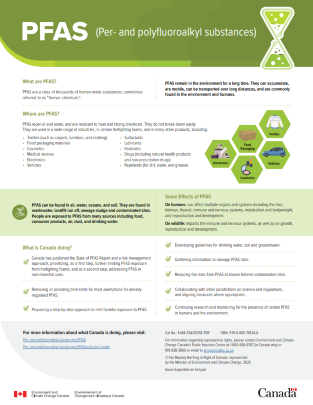What are PFAS (Per- and polyfluoroalkyl substances)

Download the alternative format
(PDF format, 115 KB, 1 page)
PFAS are a class of thousands of human-made substances, sometimes referred to as “forever chemicals”. Negative environmental and health effects have been observed for some well-studied PFAS.
PFAS do not break down easily and remain in the environment for a long time. They can accumulate, are mobile, can be transported over long distances, and are commonly found in the environment and humans.
Where are PFAS
PFAS can be found in air, water, oceans, and soil. They are found in wastewater, landfill run off, sewage sludge and contaminated sites. People are exposed to PFAS from many sources including food, consumer products, air, dust, and drinking water.
PFAS repel oil and water, and are resistant to heat and strong chemicals. They are used in a wide range of industries, in certain firefighting foams, and found in a range of other products, including:
- Food packaging materials
- Textiles (such as carpets, furniture, and clothing)
- Cosmetics
- Drugs (including natural health products and non-prescription drugs)
- Medical devices
- Electronics
- Surfactants
- Lubricants
- Pesticides
- Repellents (for dirt, water and grease)
Some effects of PFAS
- On humans: can affect multiple organs and systems including the liver, kidneys, thyroid, immune and nervous systems, metabolism and bodyweight, and reproduction and development
- On wildlife: impacts the immune and nervous systems, as well as on growth, reproduction and development
What is Canada doing
- Canada has published the State of PFAS Report and a risk management approach, prioritizing, as a first step, further limiting PFAS exposure from firefighting foams, and as a second step, addressing PFAS in non-essential uses
- Removing or providing time-limits for most exemptions for already regulated PFAS
- Proposing a step-by-step approach to limit harmful exposure to PFAS
- Developing guidelines for drinking water, soil and groundwater
- Reducing the risks from PFAS at known federal contaminated sites
- Gathering information to manage PFAS risks
- Collaborating with other jurisdictions on science and regulations, and aligning measures where appropriate
- Continuing research and monitoring for the presence of certain PFAS in humans and the environment
For more information about what Canada is doing, please visit:
- Per- and polyfluoroalkyl substances (PFAS)
- Per- and polyfluoroalkyl substances (PFAS) and your health
- Share your thoughts until May 7, 2025: